If you have a home DIY building project coming up and you don’t know where to start, look no further. This post will teach you all about how to buy wood for DIY woodworking projects and set you up for success before you head to the store!
We are self-taught DIYers and woodworkers and never took any formal training… on anything.
That includes on how to buy wood for DIY woodworking projects.
If you look back at some of our earliest projects (uh oh, yikes), we had no idea what we were doing. We learned along the way and aim to teach our readers the things we have learned.
One thing that people often overlook right from the start is how to actually look for good wood at the store for their projects.
It’s not quite as simple as walking into a store and grabbing exactly what you need off the shelf. There are a lot of things to take into consideration when buying lumber for DIY woodworking projects that you need to know.
Below, we’ll break down everything from where to shop for lumber, how to decide what you need, how to pick out your lumber, and even how to get it home.

How to shop for lumber for DIY woodworking projects
There are a lot of factors when it comes to deciding what type of lumber you want for your DIY woodworking projects. Once you get the hang of it, you won’t even realize you’re thinking about how to buy wood for your DIY projects, it will just come naturally.
The following sections will help show you how to shop for wood for your DIY woodworking projects to help you get the best wood for DIY furniture, home renovations and more.
Where to shop for lumber
Before you can shop for lumber, you have to know your choices on where to buy wood for projects!
There are lots of choices on where to buy your lumber for woodworking and each has pros and cons for the type of project you might be working on or the quality you want for your finished product.
Here are the most common options on where to get wood for DIY projects.
Big box home improvement stores
Big box home improvements stores, such as Lowe’s and Home Depot, are going to give you the best access to a wide variety of wood for projects.
Home improvement stores are usually much more easily accessible and have a large selection, high volume of each option, and offer a decent price. Home improvement stores also will offer you the most consistent selection from trip to trip.
If you are a beginner or occasional woodworker or DIYer, a big box home improvement store is a popular choice for the best place to buy wood for projects to meet your needs consistently.
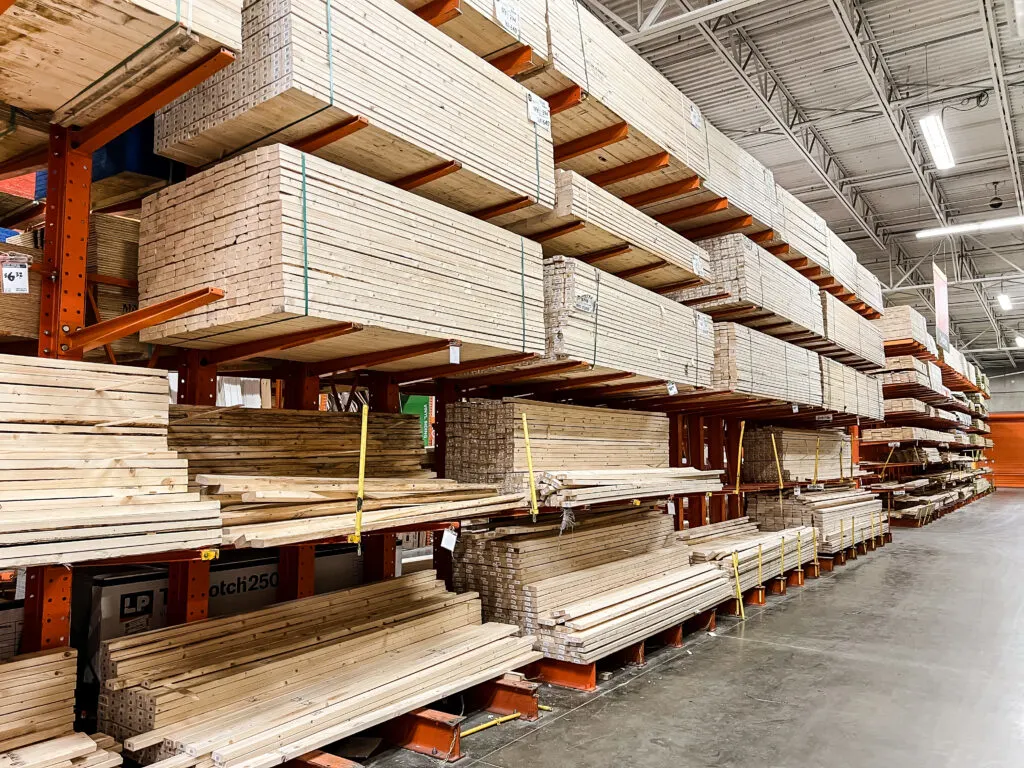
Types of wood typically available at home improvement stores include:
- Pine
- Poplar
- Oak
- Cedar
- Cypress
- Plywood
- Treated lumber
The negatives of buying wood for woodworking projects at a big box store is that they usually will not have high-quality lumber, they are at the mercy of their suppliers and you will pay market price, even for bad wood.
You often have to sort through a lot of pieces of wood just to get a good piece, especially when purchasing lower-cost wood types like pine or construction lumber.
Speciality wood stores or lumber yards
Speciality wood stores and local lumber yards are the best place to get high-quality wood in species you might not have thought of, or if you are looking for something very specific.
Specialty wood stores and lumber yards are going to have a large selection of high-quality hardwoods, but there might not be as much or as consistent of pieces as a big box home improvement store.
The wood from these places is also going to be much more expensive.
We got a slab of curly maple for our fireplace makeover from a lumberyard!
With lumber prices currently at an all-time high, specialty hardwood lumber is now less cost-prohibitive because prices haven’t been affected as much as dimensional lumber from the hardware store. This gives buyers an opportunity to try something new.
Specialty wood stores and lumber yards will also offer high-quality cuts with dried and planed smooth boards that are almost always going to be smooth and straight.
These stores can seem intimidating, but the people that work there are usually really interested in lumber and are happy and excited to talk to you about what you need.
Local online woodworking groups
Another great resource for where to buy wood for DIY furniture and woodworking is local online woodworking groups. If you search google or facebook, I bet you will find a woodworking group for your city.
There are tons of Facebook groups that are dedicated to the woodworking trade in your area and will feature members with lots of experience and be a good source for live edge wood and trades.
The local Charleston Wood Guild is very active, with members helping each other with questions, offering services and selling/trading wood.
This is a great option for getting to know other people in your area and getting lumber for cheaper prices than you would elsewhere.
Types of wood to buy for DIY projects
There are many types of wood to buy for DIY projects, including hardwoods and softwoods as well as plywood and pressure treated lumber for outdoor projects.
Let’s take a look at the different options!
Hardwoods
In general, most DIYer’s are not going to go for extremely expensive hardwoods. They aren’t readily available and aren’t where you want to practice.
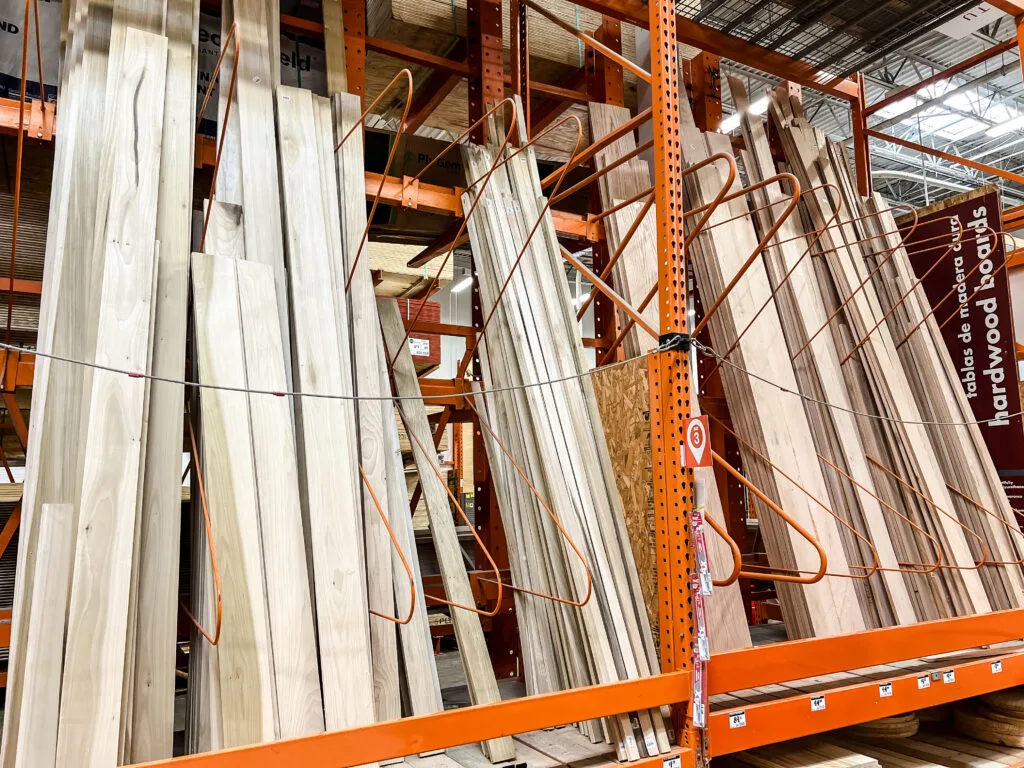
In general, the best hardwoods for DIY projects are oak and poplar. These are usually always available at your local hardware store and are relatively cost-efficient.
Some people will scoff, but we personally love the look of poplar. It can have an incredible grain pattern and coloration. Take a look at some of these examples available just at one time at one store.
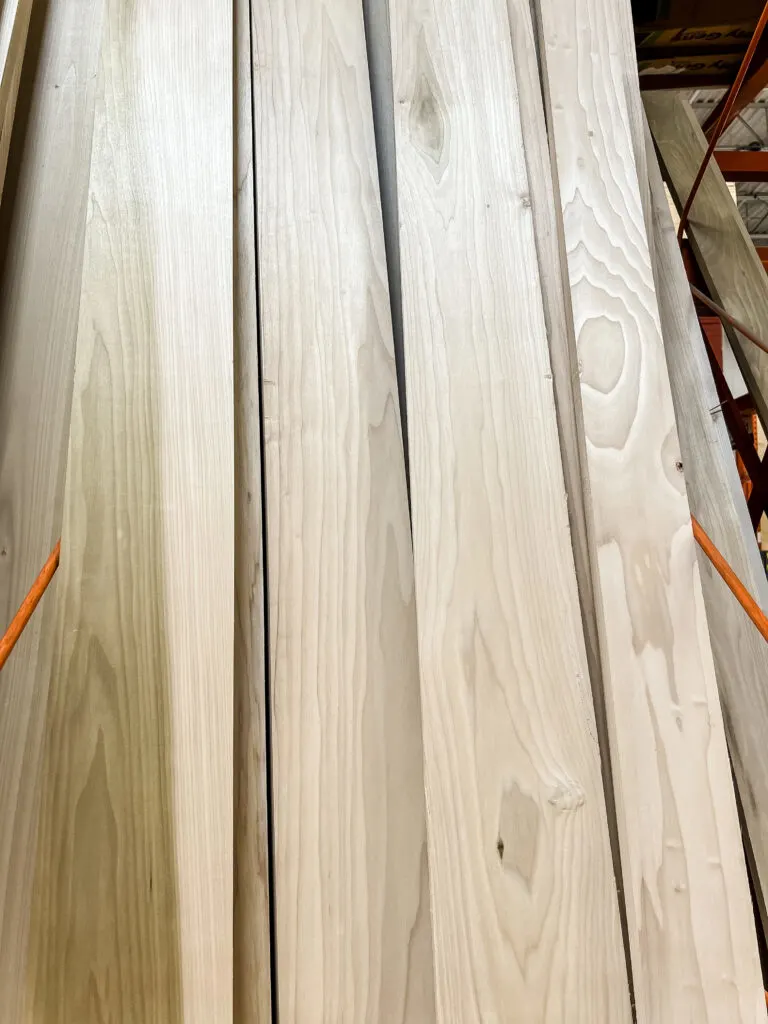
This whole dining table we made from poplar from the hardware store!
The thing to watch out for about poplar is that it can often have a green tint to it, so make sure to avoid those pieces.
Oak is wonderful and has beautiful grain. Oak usually is always straight, solid, has good coloration and low defects.
We made this tiered serving tray out of oak from the hardware store!
Oak is going to be the most expensive type of wood you find at a hardware store, but if you’re making a statement piece that will be on display in your home, this is a great choice.
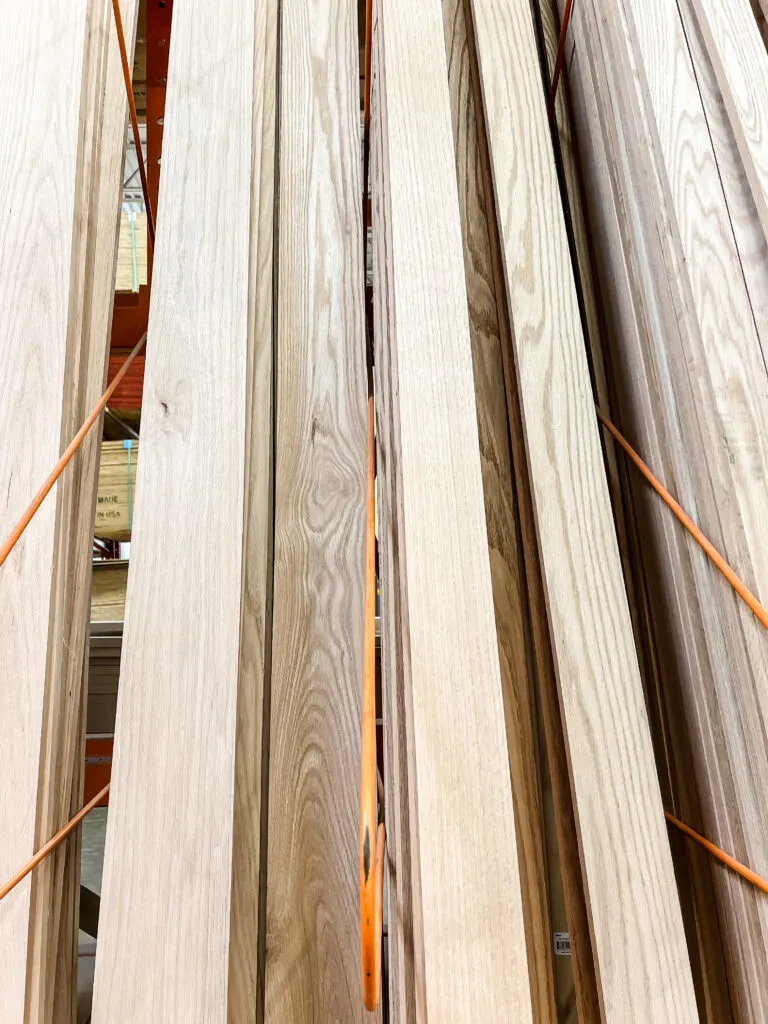
Soft woods
Soft woods are the cheaper alternative at any store, but they come with the cost of often not being in the best condition.
Soft woods at the hardware store are going to usually include pine and what stores will either call “white wood” or “common wood.”
Soft woods are great if you are trying to be cost-conscious or if you are going to be painting your furniture build. Soft woods will often be covered in knots and strange grains, so unless you’re going for a rustic look, these might not be your best bet.
Click here for a dollhouse shaped bookshelf we built with soft wood and painted!
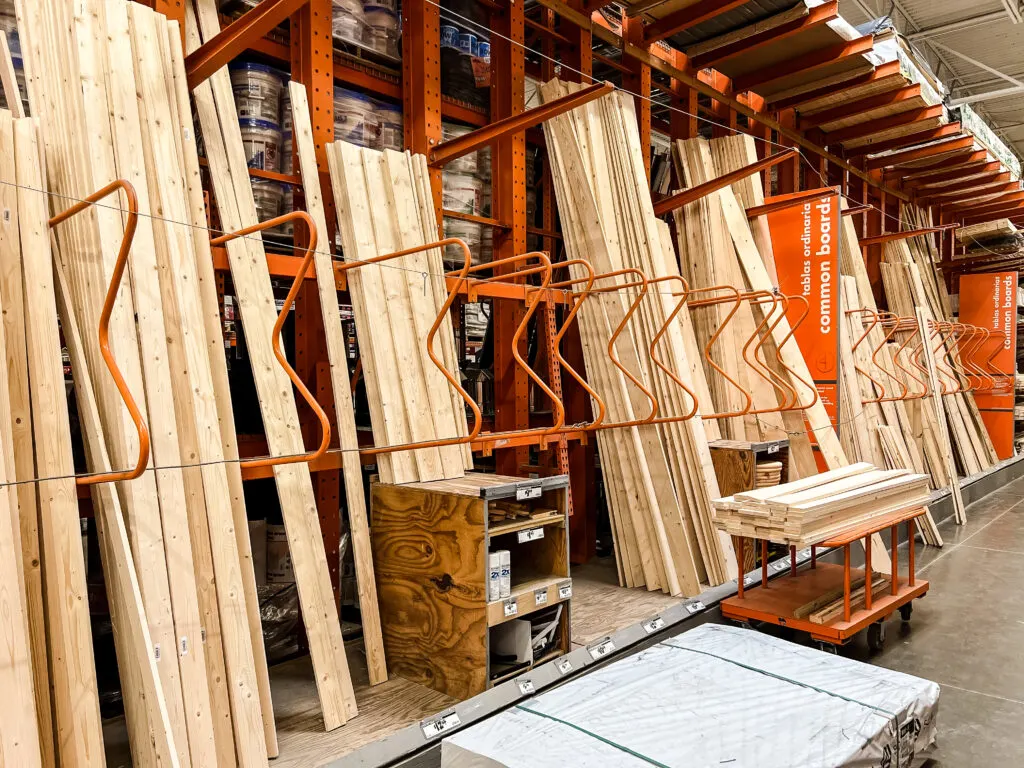
Plywood
Plywood is manufactured sheets of wood that are a composite of wood shavings and glue pressed together with a thin wood veneer on the outside layer.
Plywood is a great choice for a lot of DIY projects because you get a lot more wood for much cheaper than if you buy boards. However, you’ll have to cut it down.
Cutting your own plywood will be more difficult because you need more space and tools and it is very heavy and cumbersome, but it is a great option to customize the sizes of boards you need for your project.
Plywood is a great option especially for large projects because you can build frames much easier.
Click here to see how to drill pocket holes in plywood for furniture projects!
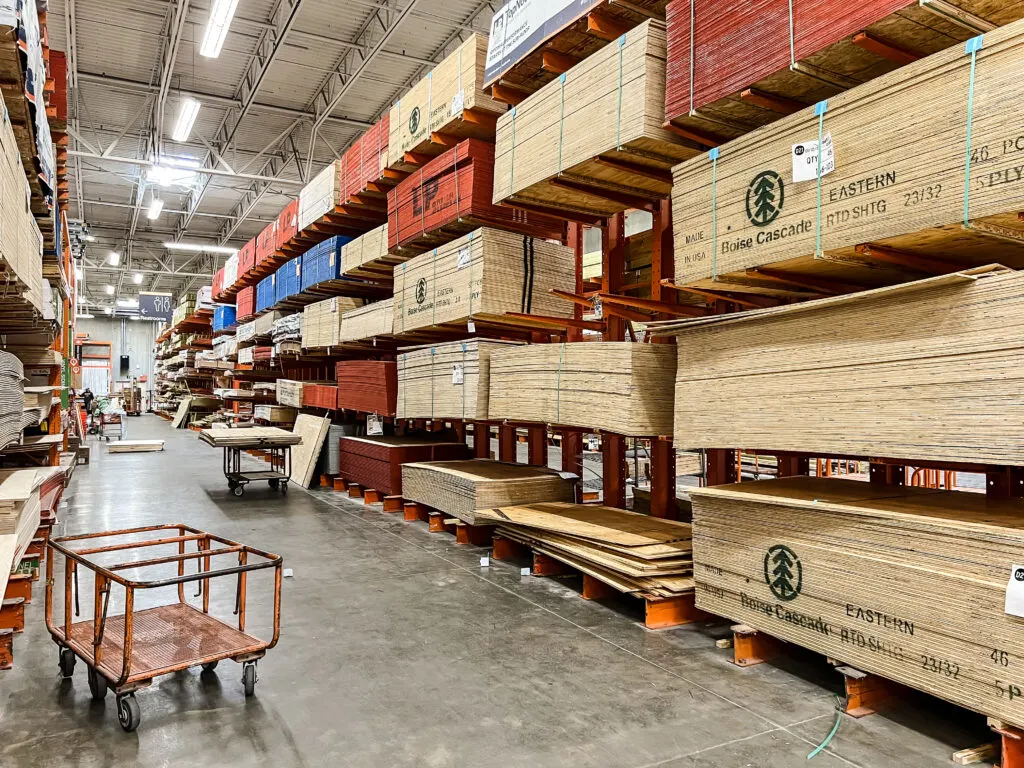
Pressure treated lumber
Pressure treated lumber is for use on outdoor projects only as it is coated in a special chemical to prevent it from rotting outside.
Pressure treated lumber is great for outdoor projects, but will usually be still wet in the store and needs to dry out before it can be used, meaning you can’t get started that day.
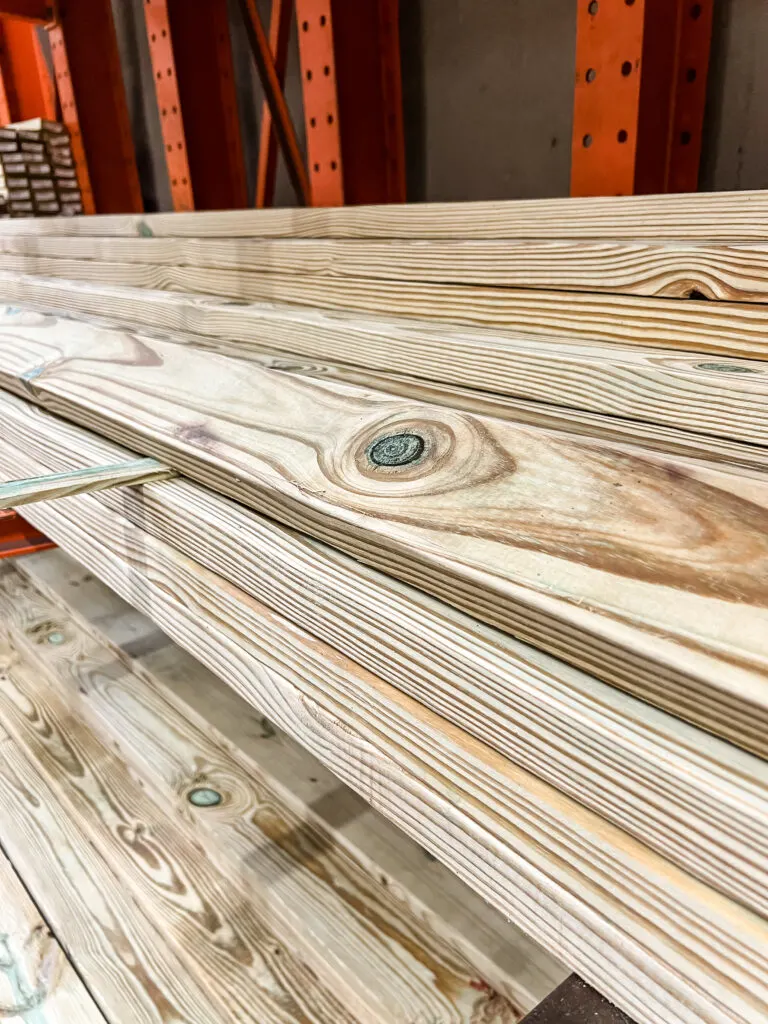
Actual vs. Common board measurements
One crazy thing that we didn’t know when we started doing DIY woodworking projects is that boards are not the dimensions they say they are.
Huh???
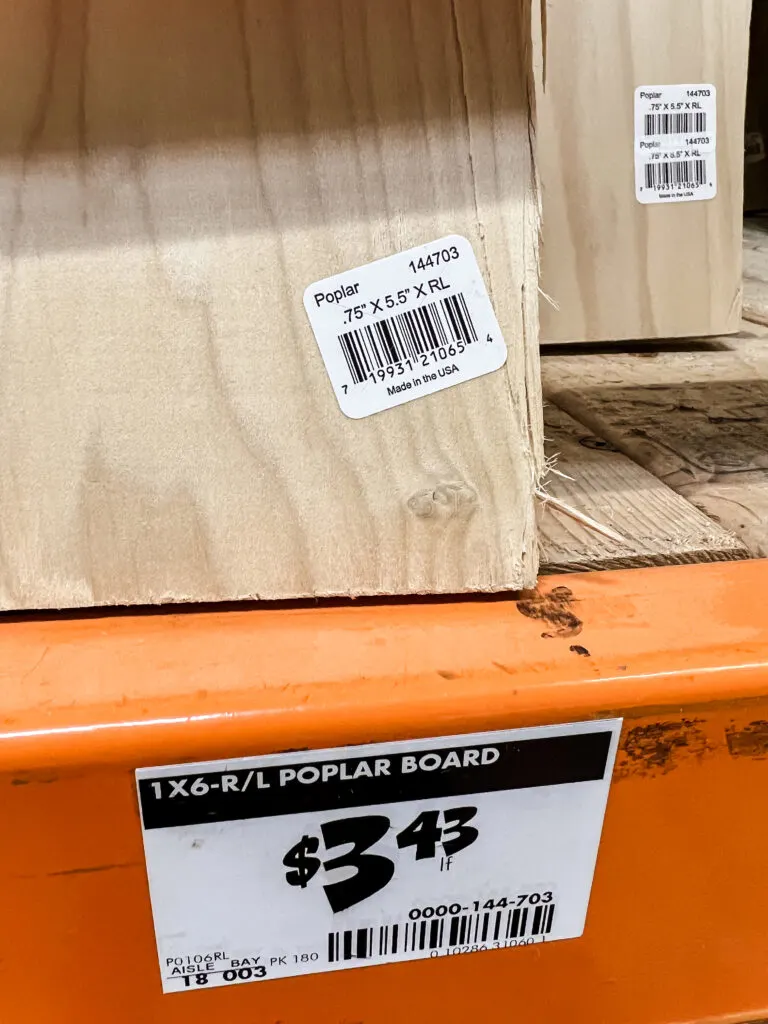
This is what is known as actual versus common (or nominal) board measurements. Lumber is labeled by its common measurement, such as a 1″x8″ or a 2″x4″ because historically, these were the dimensions. Over time, manufacturers began to mill the wood differently to a smaller processed size.
When following a woodworking plan or blog post, when someone refers to a 1″x4″, they mean a board that is actually 3/4″x3 1/2″.
Click below to download our free and convenient chart showing the most common sizes of lumber and their actual dimensions.
Things to look out for when buying wood
There are a lot of things to look for when buying wood for DIY projects. There are positive and negative qualities to wood and no two boards are the same.
Here are some of the most important things to look for in a board when buying lumber.
Things you want in lumber
There are a lot of things you want to look for in good pieces of lumber at the store for DIY woodworking projects.
The main things to look for in wood are good grain patterns, good color and straight on all sides.
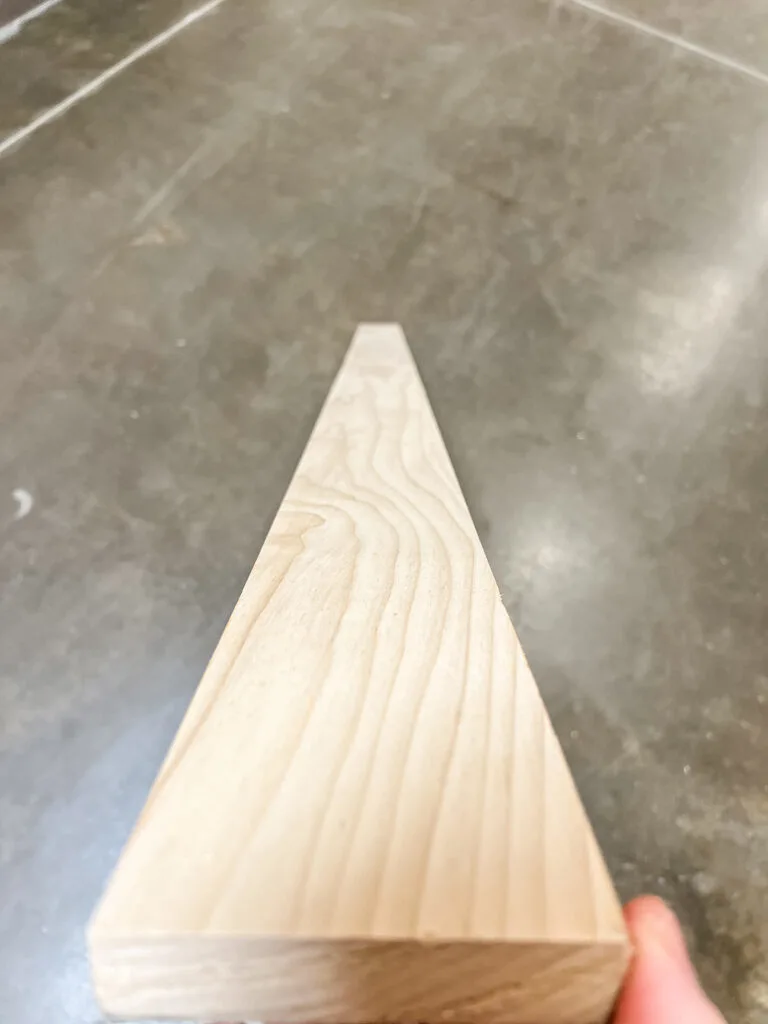
When it comes to plywood, you should always look for wood that is sanded on both sides and has the least number of voids (gaps) on the edges.
There are a lot of different ways that the same type of wood can look from board to board, so you should pick the ones that make you happiest and you think would go well in your space at home.
Things you don’t want in lumber
Even more so than good things you want to look for, there are a lot of bad things you want to look for when picking wood at the store.
Large knots, gouges, cracks, curves, warps and cupping are a few of the things you don’t want in your wood when doing a DIY woodworking project.
All of these elements will cause problems when doing projects, whether in the construction or the finishing.
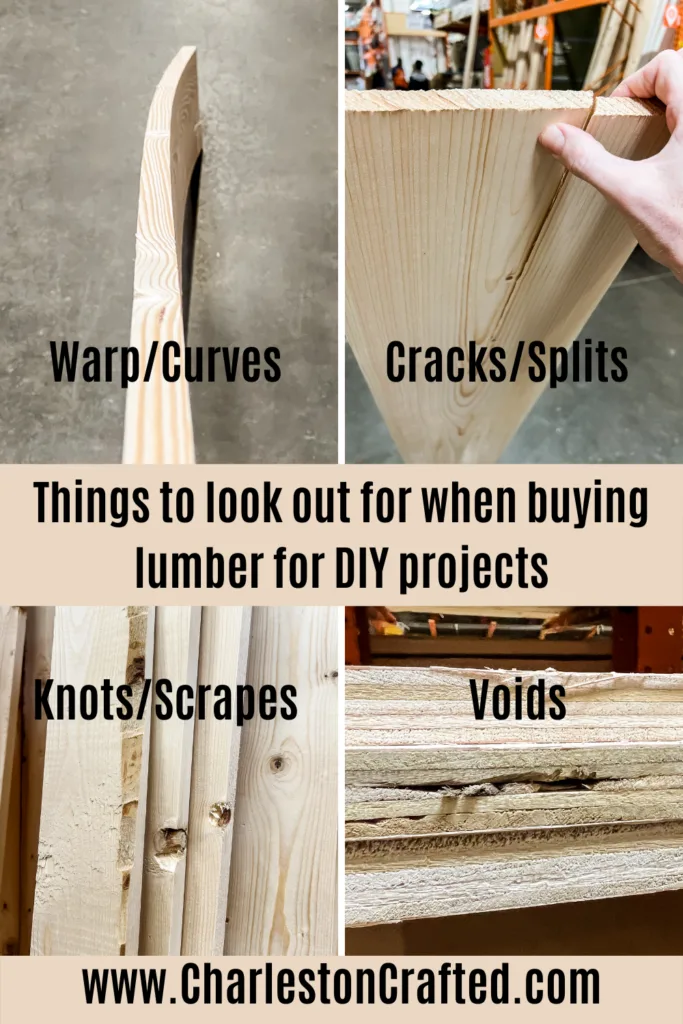
How to inspect wood at the store
Knowing how to inspect wood at the store is a great skill to have. Aside from all the other things above to look out for, here’s how to physically inspect wood at the store when picking your pieces.
The best way to inspect your wood is to hold each board at an angle from the ground to your eye. Then, close one eye and look down the board on each side. If you see the board curving or warping, put it back and don’t buy it.
Inspecting your wood at the store is important so you don’t waste money on boards that are going to cause problems with your builds.
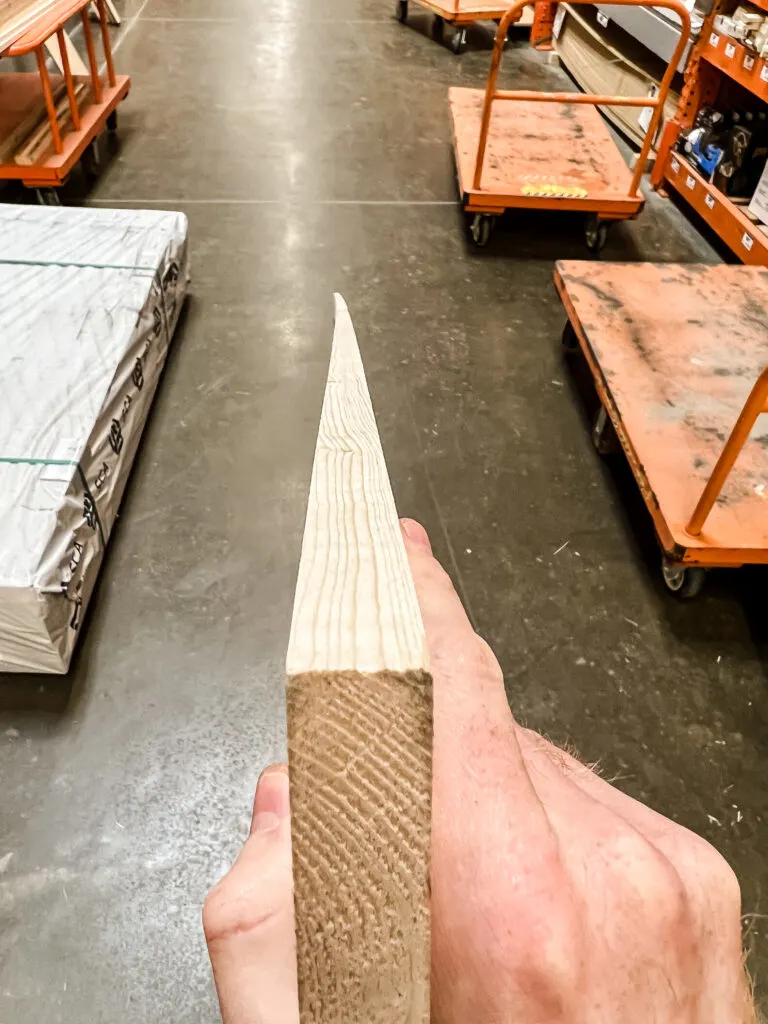
How do you get wood home from the store?
Once you’ve picked out your wood from the store, you have to get it home. The easiest way is if you have a pickup truck or have access to a friend’s truck.
If you don’t have access to a truck, you can get roof racks attached to your vehicle if you regularly need to strap wood to your car. Grab some ratchet straps and tighten them to keep the wood from falling off.
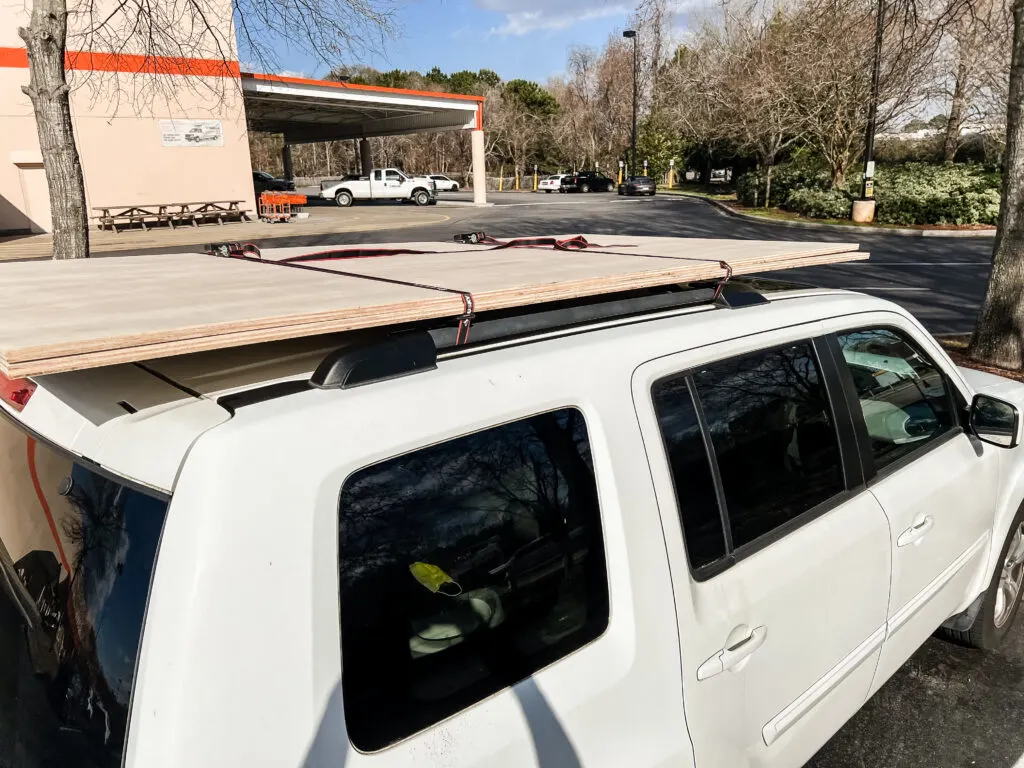
Hardware stores will also cut down wood for you in the store, which can be good if you know the lengths you need. This also makes it easier to get in the car.
If you don’t need wood often and don’t have a truck, you can often rent a truck from a local hardware store. Home Depot has them available for a small amount of money. We know people who batch buy their lumber for multiple projects, rent a truck and then only do that one trip every so often.
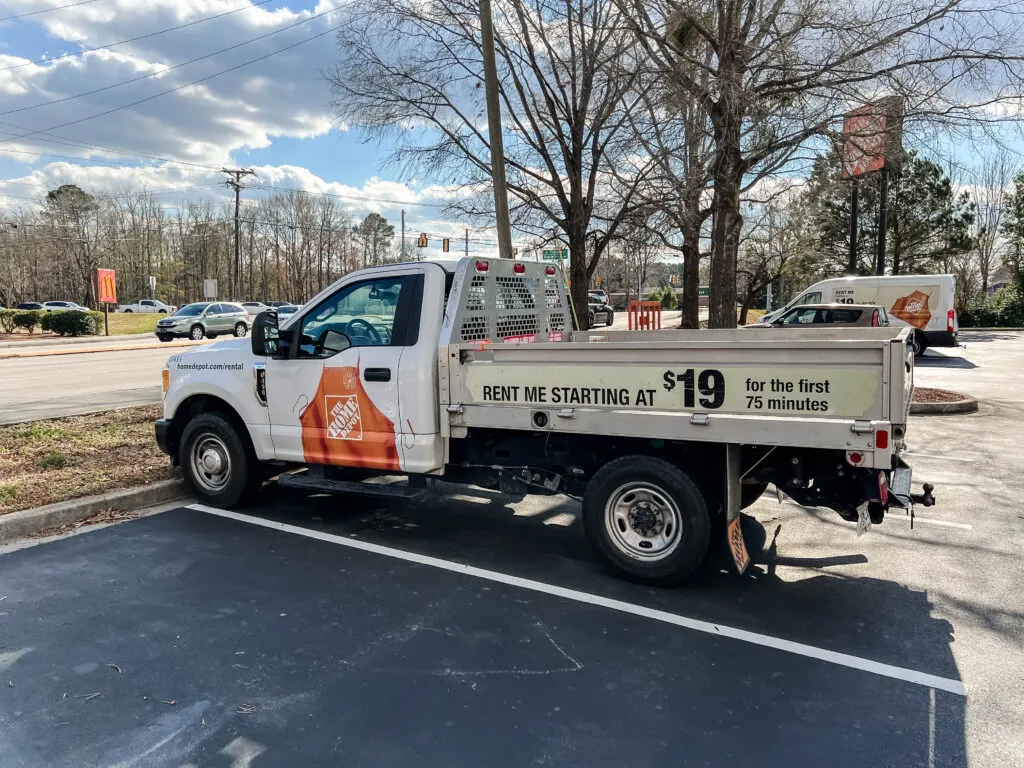
How do I store wood for projects?
Finally, once you’ve picked out all of your lumber and gotten it home, what do you do with it?
It’s best if you can use wood immediately, but if you need to store it at home, you can build a lumber storage rack of some kind to keep the wood off the ground.
We have plans available for a rolling lumber storage cart and for a vertical wall storage rack, but you can figure out what is best for your situation!
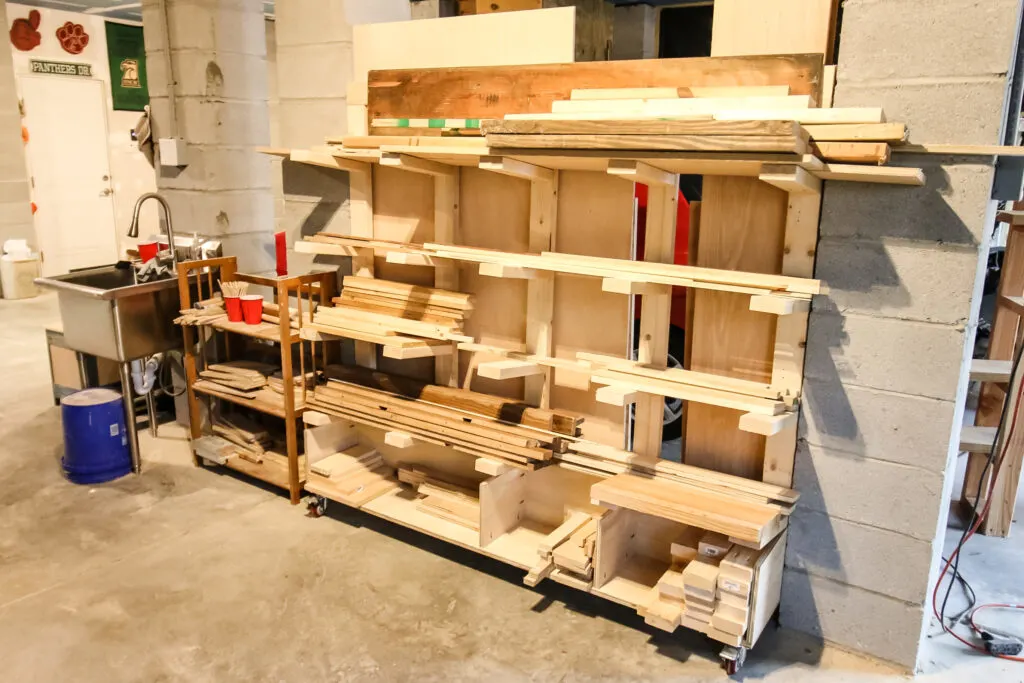
Basic woodworking information for every project
Here are some of our most popular woodworking articles!
Shopping for wood:
Woodworking project ideas
- 100+ of the best woodworking project ideas!
- 62 easy beginning woodworking projects
- Woodworking project ideas to make and sell
See all our printable PDF woodworking plans!
Our favorite tools + supplies
- See all our favorite tool reviews
- How to use a Kreg jig
- The ultimate wood stain guide
- The best wood fillers for your project
Remember to also always use safety equipment while woodworking and using tools. Make sure you have proper eye protection, ear protection and a good mask to keep yourself safe.
Any more questions about buying lumber!?
Looking for something?
We’ve been doing this since 2012 so we have a LOT of blog posts!
Search stuff like: Ceiling Projects | DIY Plant Stands | Thrift Flips


Hey there, I’m Sean, the woodworking enthusiast and builder behind CharlestonCrafted.com! Since 2012, I’ve been sharing the magic of turning raw materials into beautiful creations. I love teaching others the art and satisfaction of woodworking and DIY. I try to inspire fellow crafters to make something extraordinary out of nothing at all.
